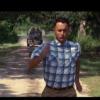Interesting on the cross trail BF crossings. Not understanding the why of that, I think it is interesting when they escort a good number of witnesses out of an area when they feel intruded upon as it seems they are expert at paralleling them and even stopping and pausing when the witness stops and pauses.
Another insight is that deer or ungulate trails frequently follow contour lines, this would intersect many straight line human trails and alot of switchback trails to some extent (not quite sure why BF wouldn't engage in the same travel patterns), full well knowing that many native american trails and later wagon roads probably were originally developed by steadfast ungulate travel patterns (probably not so much steadfast blackbear trails). This in montane environments anywhoo where I have the most experience.
On another note, I have noted that black bear in the southern appalachians often follow the beeline (not that I haven't seen deer do the same thing when heading down especially), which is a human choice too among those fit enough to put in the effort. Glad most human trails were not designed by black bear. We would have alot of erosion by-way-of shortcutting,
So the question is, if a BF is hunting an ungulate, what method of travel and ambush is it most comfortable with?
I am reminded of a BFRO sighting in Montana by an elk hunting guide on horseback who eyeballed a BF behind a rootball below the trail. Alerted by his horse, the guy got a good view of the expression on the BF's face apparently which was one of total surprise. as if it was anticipating an elk ambush instead. It sounds as if it was stationed at right-angles to that game trail.
; > }


